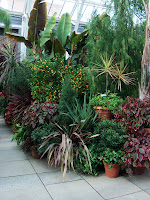Tower Hill is the home of the Worcester County Horticultural Society, a venerable organization that barely registered on the radar screen of not-for-profit institutions until it decamped from downtown Worcester for a 132-acre former farm on a hilltop in Boylston, some ten miles northeast of that city. A visitor center opened in 1994 but it was the unveiling of the 4000-square-foot Orangerie in 1999 that made Tower Hill a winter destination for me.
 |
| Tower Hill's new Limonaia |
Reduced to its simplest, both the Orangerie and the Limonaia are, essentially, large open indoor spaces with lots of plants in containers. Well, yes, but then the Venus de Milo is a chunk of sedimentary rock to which someone took a chisel.
 |
| The Orangerie at Tower Hill |
Both are extraordinary spaces, light-filled and airy, and classically proportioned. The new Limonaia has a bit more exposed concrete than I care for, but that’s quibbling. Mostly, it’s the plants that make the space such a welcome respite. We’re talking containers with mature, subtropical trees and shrubs; artfully arranged to form a garden. There are occasional fountains and statuary, with garden-appropriate tables and chairs scattered about, but the plants are the main attraction.
 |
| A garden of pots in the Orangerie |
The Orangerie hardly looks picked over for Tower Hill’s expansion. As the nearly photos suggest, it was as lushly tropical on this visit as when the Limonaia was just an excavated pit.
 |
| The Camellia Show at Tower Hill |
Camellias are not easy to grow in New England – this is not a tree you park in the nearest sunny window and expect it to thrive. Its roots and branches are hardy down to well below zero, but leaves and buds are susceptible to winter burn, making it more of a Zone 6 or 7 plant. In other words, a cool greenhouse is a nice accessory to have if you’re interesting in pursuing camellias as a hobby.
There were hundreds of specimen blossoms on display and judges still at work when we arrived. We watched them work, marveling at their attention to detail. All in all, a very satisfying visit.
Tower Hill is, of course, far more than a winter destination. But in summer there are parks and reserves that are much closer and offer comparable experiences. At least for me, winter is Tower Hill’s time to shine.


